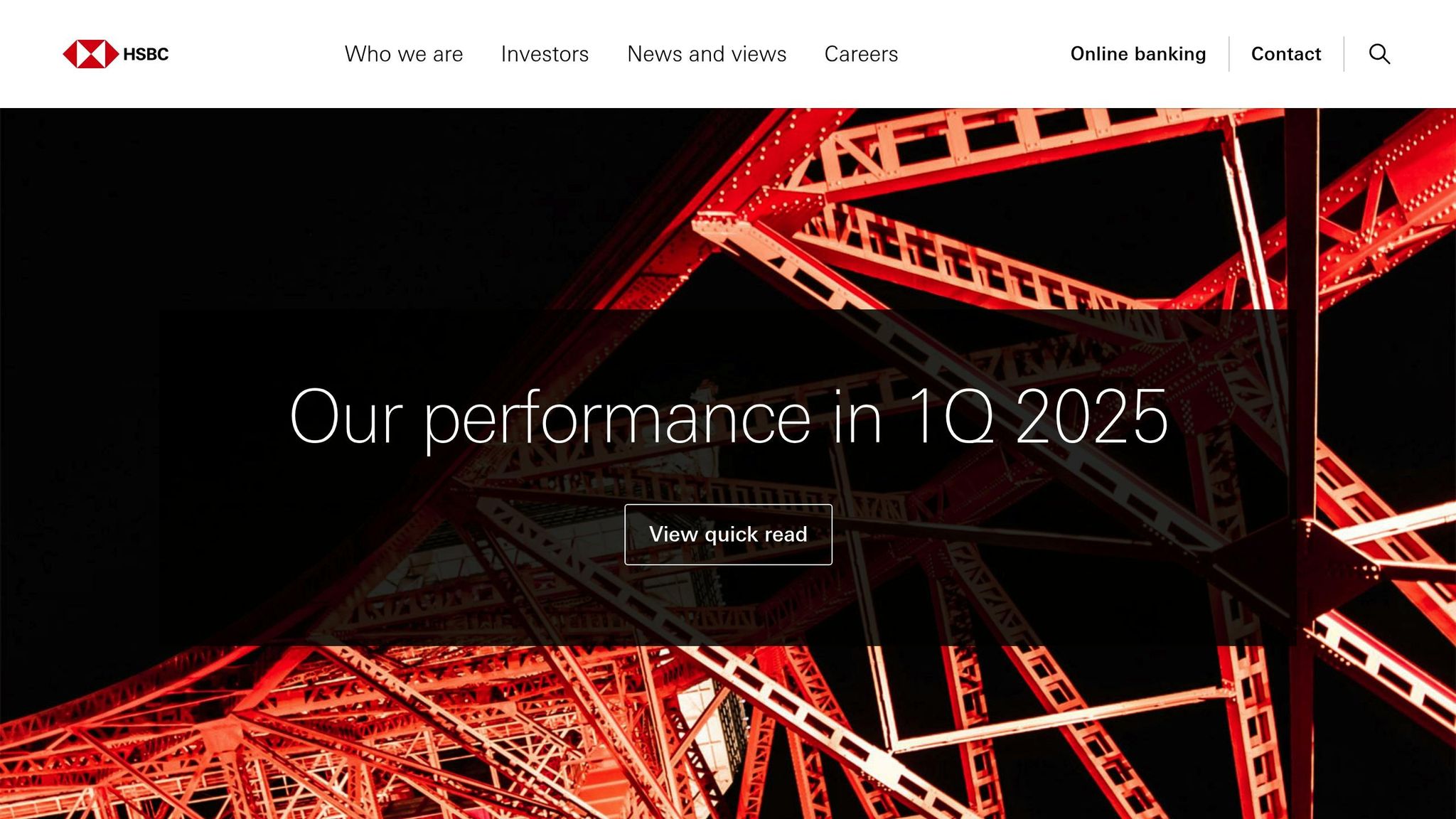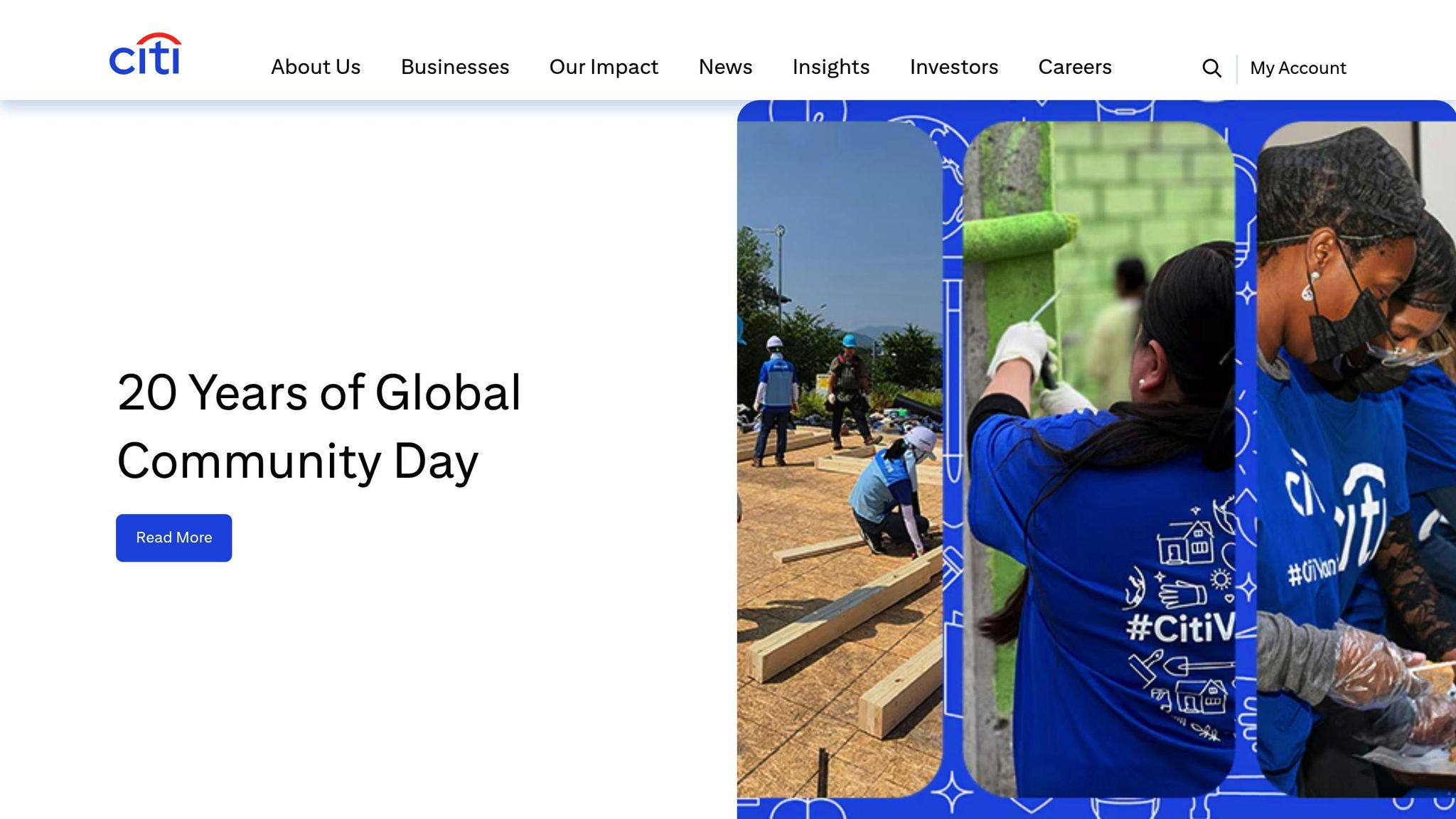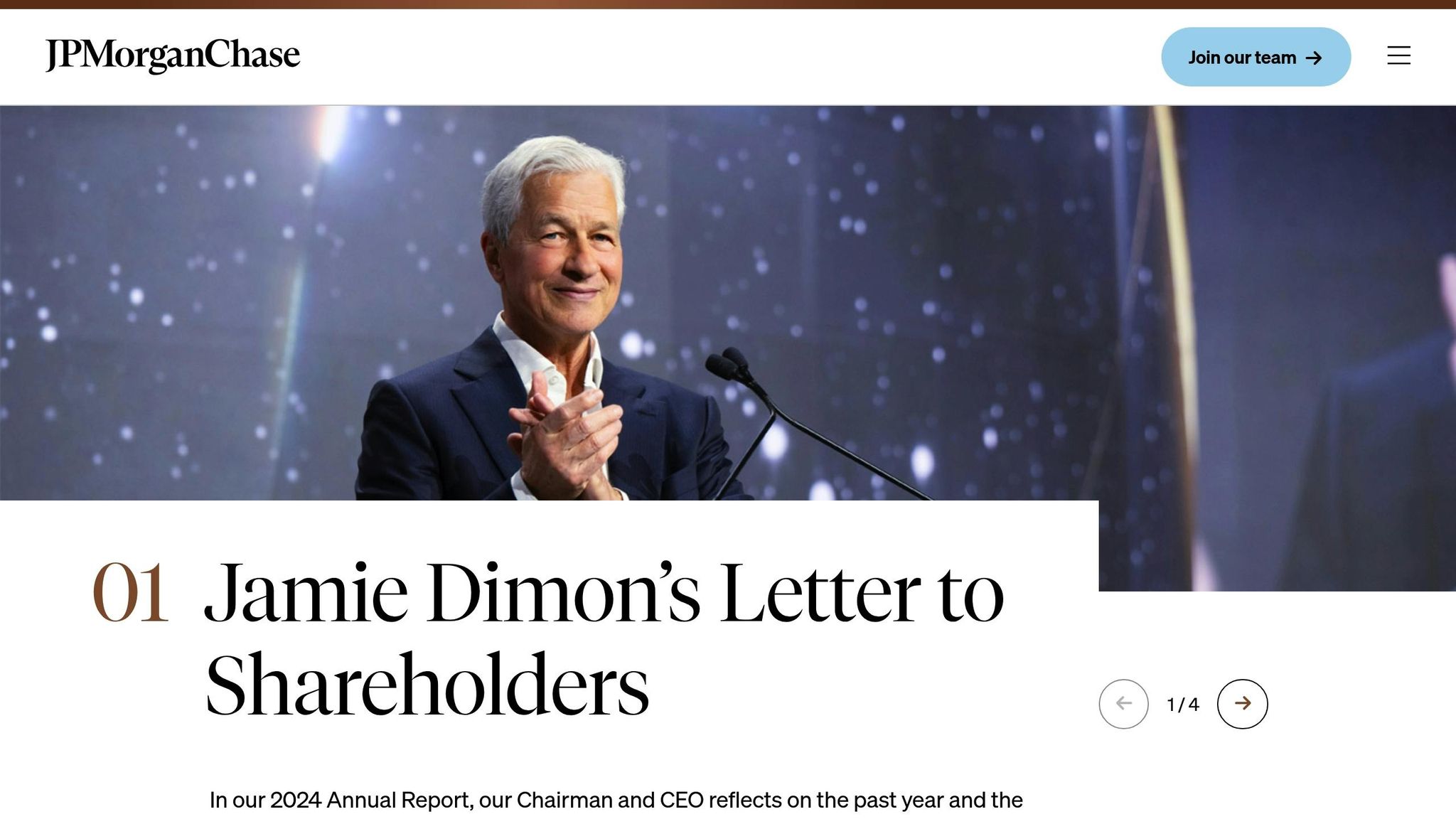
Omnichannel marketing isn't just a trend - it's how financial institutions meet modern customer expectations while driving growth. Dive into these case studies to see how it's done.
The following case studies dive into real-world examples of how businesses have successfully implemented omnichannel marketing strategies. Each one offers insights into practical solutions and measurable outcomes.

HSBC elevated customer engagement by adopting Pega's centralized real-time decision engine, which automated and localized campaigns across multiple channels. Recognizing the limitations of manual campaign management, the bank shifted its focus to creating dynamic, client-focused interactions that adapt in real time. By integrating this decision engine with its CRM system across 44 markets, HSBC streamlined workflows for client-facing teams. Additionally, they invested in an analytics suite and a content management platform to support 10,000 users of their enablement tools.
"We wanted enablement to be part and parcel of our CRM as it was important to have a truly seamless experience for our client-facing teams." - James Bickerton, Global Head of Client Development at HSBC
The results were striking: click-through rates increased 3.5 times on the web and by 200% for email campaigns. This approach demonstrates how digital tools can transform customer engagement.

Bank of America created a unified experience by connecting its mobile apps, websites, ATMs, and 3,800 retail financial centers. This omnichannel strategy ensures that customers can start a transaction on one platform and finish it on another. For instance, branch staff use tablets to access customer profiles created through mobile interactions, providing a seamless transition between digital and in-person services. Features like appointment scheduling, cardless ATM access, and integrated maps further enhance the customer journey.
Bank of America's virtual assistant, Erica, plays a pivotal role in this ecosystem. Erica has handled 659 million interactions with 24.6 million clients, including 123 million interactions in Q4 2021 alone - a 247% increase from the previous year.
"Erica acts as both a personal concierge and mission control for our clients. Erica meets clients where they are and when they need us, and has become a true guide by their side." - Nikki Katz, Head of Digital at Bank of America
The results speak volumes: 86% of deposits now occur through digital or ATM channels, over 85% of small business clients use digital services, and Zelle transactions (514 million) surpassed physical checks (453 million) in 2021.

Citi introduced the Customer Analytic Record (CAR), an advanced data integration system that consolidates customer information from all interactions, products, and channels. By combining qualitative data (like zip codes and home ownership) with quantitative data (such as transaction history), Citi creates detailed customer profiles. This allows the bank to deliver highly personalized experiences based on customer behavior and preferences.
For example, when a customer booked a hotel stay coinciding with their birthday, Citi used this insight to surprise them with a thoughtful gesture, strengthening the personal connection. The bank’s Omnichannel Decision Engine, powered by Pega Customer Decision Hub, analyzes interactions in real time to recommend tailored services across web, mobile, branch, and agent channels. This system achieves 100% traffic coverage on web and mobile platforms.
"We're not pushing things to our customer that they don't necessarily find relevant, because they've indicated to us that they're not interested, at least not right now." - Promiti Dutta, US Personal Banking, Citi

Mashreq Neo, the digital arm of Mashreq Bank, tackled onboarding challenges with a data-driven approach. Using cohort retention analysis, the bank identified specific points in the onboarding process where customers were likely to drop off. This analysis helped them pinpoint peak and low activity periods within the app.
To address these challenges, Mashreq Neo implemented unified onboarding workflows that included in-app messaging, push notifications, email, SMS, and IVR. This coordinated effort reduced manual intervention while enhancing the user experience. The results were impressive: a 16% increase in debit card activations, a 50% boost in click-through rates, and 23,000 new customers onboarded in just three months.

JPMorgan Chase took a data-driven approach to omnichannel marketing, using advanced analytics to track customer journeys and optimize interactions across multiple touchpoints. By aligning messaging across mobile, web, email, and branch channels, the bank created cohesive experiences that increased customer engagement and satisfaction. This strategy not only improved product adoption but also boosted customer lifetime value.
These cases underline how financial institutions can use omnichannel strategies to deliver seamless, personalized experiences while achieving measurable results.
To run a successful omnichannel campaign, financial institutions need to focus on three core elements: data integration, AI-driven personalization, and consistent messaging across channels. These strategies not only enhance the customer experience but also deliver measurable business outcomes.
A strong omnichannel strategy starts with a unified customer view, made possible by tools like Customer Data Platforms (CDPs) and integrated CRM systems. These systems help banks and financial institutions better understand their customers and improve service delivery.
Here’s a telling statistic: 72% of marketers use a CDP alongside other tools to fine-tune their outreach and measure performance. McKinsey also found that companies that personalize their efforts see 40% higher revenue compared to those that don’t.
"A Customer Data Platform (CDP) is a solution that enables you to collect, store, model, and activate customer data. The purpose of a CDP is to provide a centralized platform to create unified customer profiles and build personalized experiences." - Hightouch
For financial institutions, the key is to adopt systems that integrate smoothly with core banking systems, loan origination platforms, and other essential tools. This creates a comprehensive view of customer profiles, activities, transaction history, and touchpoints.
With this centralized data, banks can segment customers based on demographics, behaviors, and financial goals. This level of detail allows for highly targeted marketing campaigns and personalized product recommendations that align with specific customer needs. And this, in turn, sets the stage for AI-driven personalization.
AI takes customer data and turns it into actionable insights, enabling financial institutions to deliver real-time, tailored experiences that drive engagement and revenue. According to MMA Global, personalization is the top application of AI, with 44% of organizations scaling it to better anticipate customer needs.
Nearly half of organizations report measurable productivity or revenue gains from AI-driven personalization, with 26% seeing consistently strong positive results.
"AI's ability to analyze internal data produces predictive insights, which marketing can use to understand our clients' needs better. This information allows us to personalize messages based on the client's preferences." - Erin Pryor, Chief Marketing Officer at First Horizon Bank
One of the most exciting advancements in this area is real-time behavioral tracking. Advanced AI platforms can predict customer behavior, optimize campaigns on the fly, and update customer profiles in real time. This ensures that financial institutions deliver the right message at the right moment, no matter the channel.
AI also simplifies operations by automating tasks like content creation and campaign management. From personalized product recommendations to welcome email series and dynamic SMS campaigns, AI adapts messaging based on customer responses, freeing up marketing teams to focus on strategy.
Personalization is powerful, but it needs to be paired with consistent messaging across all channels. Consistency builds trust, and trust keeps customers loyal. In fact, companies with strong omnichannel strategies retain 89% of their customers. On the flip side, 32% of customers will leave a financial institution after just one poor customer service experience.
"Consistency isn't just repeating a tagline or using the same logo. It's about making sure every customer touchpoint reflects the same values, tone and trustworthiness – whether someone is using a mobile app, receiving an email or meeting with a financial advisor in person." - Serena Spiezio, Strategic Efforts Lead, GAVIN™
To achieve this, financial institutions should create comprehensive brand messaging guides. These guides outline the tone, voice, and key messaging pillars, ensuring that every team member - whether in marketing, customer service, or sales - understands how to communicate with customers.
Technology also plays a key role. CRMs and marketing automation platforms help centralize messaging templates and ensure that every customer interaction aligns with the brand’s values.
Finally, cross-functional training is critical. When everyone - from digital marketers to customer service reps - understands the brand’s communication standards, customers enjoy a seamless experience, no matter how they interact with the institution.
The case studies highlight three key insights that can reshape omnichannel marketing for financial institutions. When applied effectively, these strategies deliver measurable outcomes.
In the fast-paced world of financial services, speed is everything. Companies that use real-time financial reporting are 20% more likely to hit their targets. By leveraging AI-powered decision engines, some firms have cut decision latency by up to 65%, enabling quicker and smarter responses during critical moments.
The move from monthly or quarterly reporting cycles to daily - or even hourly - updates has completely transformed decision-making. For instance, AI applications have reduced case resolution times by 45% while boosting customer retention by roughly 35%.
Here’s an example: imagine a customer abandons a loan application midway. A real-time system can instantly send personalized follow-up messages through multiple channels. Instead of waiting days for batch processing, the system acts within minutes, significantly increasing the likelihood of the customer completing the application.
75% of CFOs plan to increase AI investments, and 68% already view it as critical for financial reporting. This growing reliance on AI-driven insights means that financial marketers who fail to adapt risk falling behind competitors who can react instantly to customer behavior.
These advancements in real-time decision-making lay the groundwork for seamlessly merging digital and physical customer experiences.
Building on the ability to make rapid decisions, leading banks are blending the convenience of digital tools with the personal touch of in-person service. While 97% of millennials use mobile banking, 66% of consumers still want to be within 15 minutes of a local branch.
One European bank took an innovative approach by converting 60 of its 240 branches into advisory centers. Customers could get help with complex financial matters, enjoy coffee, or even work there. The results? A 25% boost in customer satisfaction, a 60% jump in traffic for high-value advice, and a doubling of sales for key products, all while reducing the total number of branches by 45% over three years.
Interestingly, transactions now account for as little as 5% of branch activity. Modern branches have evolved into hubs for relationship-building and in-depth consultations, while routine transactions are increasingly handled online.
"This smooth and swift journey exemplifies a new distribution model for retail banking: one that positions mobile as the orchestrator promoting conversational customer engagement and integrating digital and human interactions so seamlessly that channels as we have always known them cease to exist." - McKinsey
Another example comes from a large Western European bank that introduced remote advisory services alongside advanced digital marketing for investment products. This approach increased assets under management by 1.5 times and doubled adviser productivity in under a year.
To succeed, financial marketers should focus on creating what McKinsey calls "phygital" experiences - where digital tools enhance physical interactions and physical spaces support digital journeys. This could mean using mobile apps to schedule branch visits or equipping branch staff with access to the same customer data available online.
Executing a successful omnichannel strategy isn’t easy. Integrating multiple channels while staying compliant with regulations requires a level of expertise that many institutions lack.
With AI adoption in finance expected to rise from 45% in 2022 to 85% by 2025, there’s an urgent need for skilled professionals to implement these technologies. Financial marketers must collaborate with IT teams, data scientists, and other stakeholders to ensure smooth integration.
Expert guidance is essential for navigating the complexities of omnichannel marketing. Visora (https://visora.co) offers specialized consulting for B2B finance, helping financial advisors, fractional CFOs, and fintech companies. Their services include developing marketing strategies, creating personalized sales funnels, implementing advanced CRM systems, and running data-driven campaigns.
The most successful financial institutions understand that building omnichannel capabilities requires both internal dedication and external expertise. They foster a culture of innovation while partnering with specialists who understand the unique challenges of financial services, from regulatory requirements to advanced technologies.
Financial marketers also need to address issues like algorithmic bias and ensure AI systems provide clear reasoning behind their decisions. Comprehensive planning - covering technical, organizational, and governance aspects - is critical. This is precisely the type of roadmap that specialized consultants can help create.
The financial services industry is evolving at lightning speed. With nearly three out of five consumers feeling optimistic about their financial future over the next six months, the demand for seamless and engaging digital experiences is skyrocketing. As we look ahead, several trends are reshaping how financial institutions connect with their customers across a variety of platforms. These trends lay the groundwork for the detailed framework designs that follow.
A mobile-first approach has become non-negotiable. Financial institutions are leveraging AI to deliver dynamic, real-time content that adapts instantly - changing images, text, and calls-to-action based on user behavior. This technology has fueled a massive 194% surge in mobile messaging across in-app notifications, push alerts, and SMS in 2024. Younger generations are driving this shift, with 52% of Gen Z and 48% of millennials already relying on digital banks. Clearly, they expect smooth, tech-forward experiences.
AI-powered personalization is also setting new benchmarks. A striking 80% of customers now expect tailored services during their financial interactions. Meanwhile, 33% of consumers express interest in AI tools for fraud detection, signaling growing trust in AI's role in financial services. By analyzing detailed customer data, banks are crafting personalized messages that deliver a unified experience across multiple channels, ensuring every interaction feels connected.
"A process of creative problem-solving in which teams of creators and strategists conceive, design, produce, and activate business solutions with the assistance of AI, intelligent automation, and data."
– Forrester
Video marketing is gaining momentum in the financial sector as well. John Sellers, Preferred Rewards Executive at Bank of America, highlighted the impact of video content:
"We see feedback where clients tell us the video helped them understand the program much better. As a result of that greater understanding, they engage deeper and bring in more assets to move up the ladder in the program."
– John Sellers, Bank of America
At the same time, ethical data collection is becoming a key differentiator. With 81% of consumers judging companies based on their data practices, financial institutions are focusing on zero-party data - information customers voluntarily share - to build trust while delivering personalized experiences.
Omnichannel integration is accelerating, with 76% of brands viewing integrated campaigns as critical for long-term success and 83% of consumers researching prices online before purchasing in-store. These strategies are already delivering measurable results, as demonstrated in earlier case studies where institutions saw significant boosts in customer engagement and retention.
Designing effective omnichannel frameworks requires specialized skills that many financial institutions may not have in-house. With over 75% of global banking customers using multiple channels to interact with their banks, integrating these touchpoints seamlessly is no small feat.
To succeed, financial institutions need unified customer data platforms (CDPs), scalable API-driven architectures, and AI-powered automation to create personalized experiences. Real-time data synchronization and robust identity management are essential, especially when navigating regulatory demands while using AI for fraud detection and compliance monitoring.
"Ideal consumers make decisions at the top of their minds and in real-time during the day using their mobile devices. Thus, embracing mobile as one of the components of an omnichannel marketing approach lets a company reach the consumers during those paramount moments that shape their choices and preferences."
– AdSpyder
A 2023 McKinsey study revealed that the average regional bank supports over 1,500 distinct customer journeys, with the typical financial services customer engaging across six different channels. Clearly, this level of complexity calls for expert guidance.
Specialized consulting can address these challenges head-on. Companies like Visora (https://visora.co) offer tailored Go-To-Market strategies for B2B financial services, helping financial advisors, fractional CFOs, and fintech firms with everything from marketing strategy and personalized sales funnels to advanced CRM systems and data-driven campaigns. These services are critical for implementing successful omnichannel frameworks.
Additionally, business continuity planning is a vital part of the equation. Dual-run environments and disaster recovery plans ensure operational resilience. External expertise can guide financial institutions through the technical and strategic hurdles of building omnichannel capabilities while maintaining compliance and security.
The most forward-thinking financial institutions recognize that omnichannel success requires a combination of internal dedication and external expertise. With 89% of consumers seeking two-way communication through messaging apps and channels, meeting these expectations demands advanced planning, technical precision, and strategic insight - skills that expert consultants are uniquely positioned to provide.
Financial institutions can breathe new life into outdated systems and break down data silos by embracing a unified data strategy. This approach brings together data from various sources into a single, accessible framework, making collaboration easier and decisions smarter. With this unified view, institutions can maintain consistent customer information - key to running personalized and impactful marketing campaigns.
Using tools like AI, data analytics, and modern CRM systems, banks and financial firms can uncover valuable insights into customer behavior. These insights pave the way for tailored marketing strategies that boost engagement, strengthen customer loyalty, and enhance the overall experience. When CRM systems are integrated with other platforms, information flows seamlessly across channels, enabling institutions to deliver a smooth and connected omnichannel experience.
AI-powered personalization is reshaping how financial services interact with their customers by offering solutions tailored to individual preferences and behaviors. By examining data such as transaction records and browsing habits, financial institutions can anticipate customer needs and provide relevant recommendations, creating a more engaging and satisfying experience.
This personalized approach builds trust and loyalty, making customers feel recognized and valued. On top of that, AI simplifies processes, speeds up response times, and delivers proactive support. The result? Stronger customer retention and a smoother, more enjoyable experience overall.
Integrating digital tools with in-person experiences is becoming essential for financial institutions aiming to meet customer expectations and foster stronger connections. Modern customers appreciate the ease of digital platforms but still value human interaction, especially when navigating complex financial decisions. While routine tasks are often handled online, research indicates that many people still prefer phone calls or face-to-face meetings for more intricate matters. Striking the right balance between these approaches is crucial for boosting customer satisfaction and building loyalty.
One effective approach is adopting a 'phygital' strategy, which seamlessly combines physical and digital channels. This might mean enhancing branch visits with more personalized services while simultaneously improving digital platforms to ensure smooth and intuitive online access. By using data analytics to better understand customer preferences, banks can deliver tailored solutions, making each interaction more meaningful and relevant.